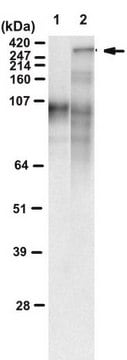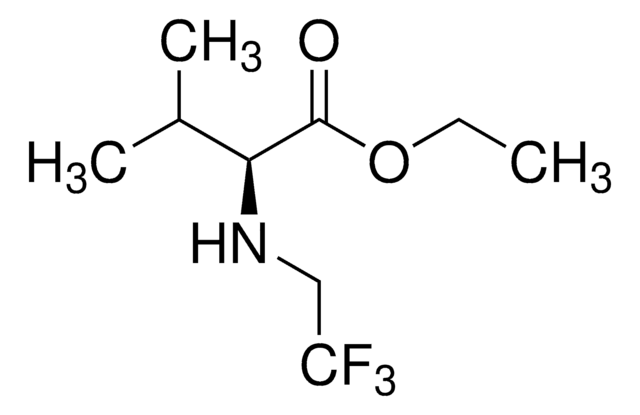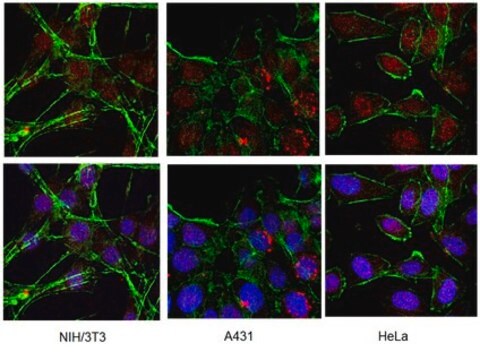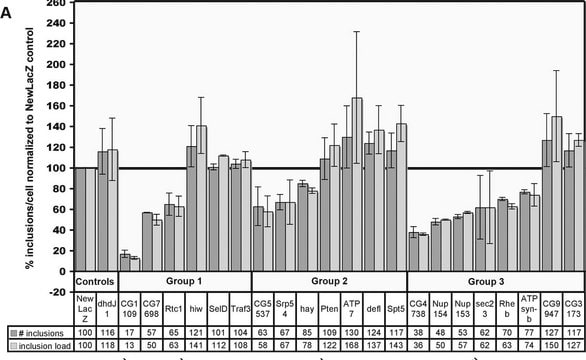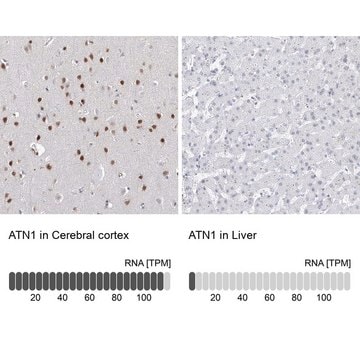추천 제품
생물학적 소스
mouse
Quality Level
항체 형태
ascites fluid
항체 생산 유형
primary antibodies
클론
5TF1-1C2, monoclonal
종 반응성
human
제조업체/상표
Chemicon®
기술
ELISA: suitable
immunocytochemistry: suitable
immunohistochemistry: suitable (paraffin)
immunoprecipitation (IP): suitable
western blot: suitable
동형
IgG1κ
배송 상태
dry ice
타겟 번역 후 변형
unmodified
일반 설명
Huntington’s disease (HD) belongs to a family of polyglutamine diseases, which includes dentatorubralpallidoluysian atrophy (DRPLA), spinobulbar muscular atrophy (SBMA) and spinocerebellar ataxia (SCA) types 1–3, 6, 7 and 17. In these diseases, the non-pathogenic alleles contain fewer than approximately 35 consecutive glutamine repeats and encode a normal polyglutamine domain. In contrast, the pathogenic alleles usually contain 39 or more consecutive glutamine repeats. Higher repeat numbers lead to lower ages of onset. Patients with 40-60 glutamine repeats normally develop disease as adults, whereas patients with more than 60 repeats develop a juvenile onset disease. Each polyglutamine expansion disorder displays characteristic pathology, with neuronal loss evident in specific regions of the brain. HD results from expansions of a glutamine tract in a large cystolic protein known as huntingtin.
특이성
The epitope of MAB1574 was found to be a homopolymeric glutamine stretch. The original immunogen was the general transcription factor TATA Box-binding protein (TBP) which contains a 38-glns stretch (Lescure et al). Other polyglutamine-containing proteins are recognized by the MAB1574, notably those involved in several human neurodegenerative diseases caused by a CAG repeat expansion, like Huntington′s disease and spinocerebellar ataxia type 2, 3 and 7 (Trottier et al., 1995). Importantly, for proteins involved in these neurodegenerative disorders, MAB1574 showed remarkable property of detecting much better the pathological proteins that contain a polyglutamine expansion (37 glns) than the wild type proteins (Trottier et al., 1995). MAB1574 has been used to identify new neurodegenerative diseases caused by polyglutamine expansion and to help for cloning of the corresponding affected genes (Trottier 1995-1998; Imbert 1996; Stevanin 1996). MAB1574 is also able to detect intracellular inclusions, which is a hallmark of such diseases (Paulson, 1997).
면역원
N-terminal part of the human TATA Box Binding Protein (TBP).
애플리케이션
Anti-Polyglutamine-Expansion Diseases Marker Antibody, clone 5TF1-1C2 is an antibody against Polyglutamine-Expansion Diseases Marker for use in ELISA, IC, IH(P), IP & WB.
ELISA: 1:1,000-1:20,000
Western Blot: 1:1,000-1:20,000
Immunohistochemistry on frozen and paraffin sections (human tissue): 1:1,000-1:20,000
Immunocytochemistry on transfected cells: 1:1,000-1:20,000 Immunoprecipitation: 1:1,000-1:20,000
Optimal working dilutions must be determined by end user.
Western Blot: 1:1,000-1:20,000
Immunohistochemistry on frozen and paraffin sections (human tissue): 1:1,000-1:20,000
Immunocytochemistry on transfected cells: 1:1,000-1:20,000 Immunoprecipitation: 1:1,000-1:20,000
Optimal working dilutions must be determined by end user.
Research Category
Neuroscience
Neuroscience
Research Sub Category
Neurodegenerative Diseases
Neurodegenerative Diseases
물리적 형태
Ascites fluid containing no preservatives.
Unpurified
저장 및 안정성
Maintain for 1 year at -20°C from date of shipment. Aliquot to avoid repeated freezing and thawing. For maximum recovery of product, centrifuge the original vial after thawing and prior to removing the cap.
분석 메모
Control
Huntigton′s Disease brain
Huntigton′s Disease brain
기타 정보
Concentration: Please refer to the Certificate of Analysis for the lot-specific concentration.
법적 정보
CHEMICON is a registered trademark of Merck KGaA, Darmstadt, Germany
면책조항
Unless otherwise stated in our catalog or other company documentation accompanying the product(s), our products are intended for research use only and are not to be used for any other purpose, which includes but is not limited to, unauthorized commercial uses, in vitro diagnostic uses, ex vivo or in vivo therapeutic uses or any type of consumption or application to humans or animals.
Not finding the right product?
Try our 제품 선택기 도구.
Storage Class Code
10 - Combustible liquids
WGK
WGK 1
Flash Point (°F)
Not applicable
Flash Point (°C)
Not applicable
시험 성적서(COA)
제품의 로트/배치 번호를 입력하여 시험 성적서(COA)을 검색하십시오. 로트 및 배치 번호는 제품 라벨에 있는 ‘로트’ 또는 ‘배치’라는 용어 뒤에서 찾을 수 있습니다.
HYPK, a Huntingtin interacting protein, reduces aggregates and apoptosis induced by N-terminal Huntingtin with 40 glutamines in Neuro2a cells and exhibits chaperone-like activity.
Raychaudhuri, S; Sinha, M; Mukhopadhyay, D; Bhattacharyya, NP
Human Molecular Genetics null
Reduction of mutant huntingtin accumulation and toxicity by lysosomal cathepsins D and B in neurons.
Qiuli Liang et al.
Molecular neurodegeneration, 6, 37-37 (2011-06-03)
Huntington's disease is caused by aggregation of mutant huntingtin (mHtt) protein containing more than a 36 polyQ repeat. Upregulation of macroautophagy was suggested as a neuroprotective strategy to degrade mutant huntingtin. However, macroautophagy initiation has been shown to be highly
Yan Hong et al.
The Journal of neuroscience : the official journal of the Society for Neuroscience, 36(34), 8790-8801 (2016-08-26)
Brain-derived neurotrophic factor (BDNF) is essential for neuronal differentiation and survival. We know that BDNF levels decline in the brains of patients with Huntington's disease (HD), a neurodegenerative disease caused by the expression of mutant huntingtin protein (mHtt), and furthermore
Suppression of neurodegeneration and increased neurotransmission caused by expanded full-length huntingtin accumulating in the cytoplasm.
Romero, E; Cha, GH; Verstreken, P; Ly, CV; Hughes, RE; Bellen, HJ; Botas, J
Neuron null
Ashish Kumar et al.
Human molecular genetics, 25(8), 1619-1636 (2016-02-26)
Identifying molecular drivers of pathology provides potential therapeutic targets. Differentiating between drivers and coincidental molecular alterations presents a major challenge. Variation unrelated to pathology further complicates transcriptomic, proteomic and metabolomic studies which measure large numbers of individual molecules. To overcome
자사의 과학자팀은 생명 과학, 재료 과학, 화학 합성, 크로마토그래피, 분석 및 기타 많은 영역을 포함한 모든 과학 분야에 경험이 있습니다..
고객지원팀으로 연락바랍니다.